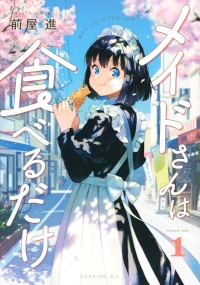This time, we’re introducing Meidosan wa Taberu Dake—a heartwarming slice-of-life manga about a maid who moves from England to Japan and discovers everyday joy through food. Perfect for language learners, it offers a gentle, low-pressure way to experience natural Japanese in daily life.
Work Information

Meidosan ha Taberudake (メイドさんは食べるだけ)
Author: Maeya Susumu
Publisher: KODANSHA
Amount of text: sparse
Challenge level: ★
Latest volume : Vol.4(Mar.2022 / Ongoing)
Story overview
Suzume, a maid who used to work at a mansion in England, ends up living in a small apartment in a corner of Japan due to certain circumstances. It’s her first time living abroad and on her own, so she has plenty of worries. But Suzume, who’s fascinated by Japanese food, eagerly steps out of her apartment! Just eating and watching food brings her so much joy! And so begins a heartwarming daily life manga about an extraordinary maid!
The Appeal of This Manga
The story follows Suzume, a mysterious girl from England who’s always dressed in a maid outfit—and all she does is happily eat delicious food. That’s it. And yet, this simple premise is surprisingly soothing, leaving you with a warm, gentle feeling.
As Suzume encounters new people across Japan, each meeting is woven together with episodes centered around tasty dishes, giving readers a charming glimpse into Japanese food culture. There’s no need to overthink—just sit back, relax, and enjoy this calm, heartwarming tale.

Why this manga is suitable for learning Japanese
This manga is not only entertaining but also highly recommended for Japanese learners for several reasons.
Suzume uses polite language as she is a maid
As the heroine Suzume is a maid, she always maintains polite language when interacting with others. Occasionally, you may notice expressions that are overly formal, but overall, it serves as a good example of polite language in everyday Japanese conversation.

Not too much text, making it easy to read
The text is generally kept concise and very easy to read, making it ideal for beginners in Japanese language learning. On the other hand, those looking for more substantial content in terms of both conversation and depth may find it a bit lacking.

Culture Spotlight
A Taste for Perfection: How Japan’s Obsession with Food Shapes Culture日本人の食へのこだわりについて
As we see in the manga Meidosan wa Taberu Dake, where Suzume finds joy in every bite of Japanese cuisine, Japan’s relationship with food is anything but ordinary. In fact, the nation’s attention to flavor, presentation, and seasonal harmony reflects deeper aspects of Japanese identity and values.
Whether it’s a rice ball from a convenience store, a popsicle from a vending machine, or a handmade dango from a tiny sweet shop, the care and pride infused into Japanese food is something that continues to fascinate visitors and learners alike.
Let’s explore what makes food such a central part of Japanese culture—and why understanding this passion is so helpful for Japanese language learners.

Gourmet Convenience: Why Japanese Convenience Store Food Surprises Everyone
First-time visitors to Japan are often amazed by the quality of food available at konbini (convenience stores). A simple egg sandwich, seasonal bento box, or even a chilled dessert can taste like something from a specialty shop.
This is because major chains like 7-Eleven, Lawson, and FamilyMart fiercely compete not just on price, but on freshness, flavor, and originality. Limited-edition treats and region-specific items are common, and many products are designed in collaboration with chefs or food critics.
・Example: 「セブンのたまごサンド、マジで神レベル。」
“7-Eleven’s egg sandwich is seriously god-tier.”
Sweet Simplicity: Japan’s Local Dessert Shops
Japan’s love for food extends beyond convenience stores to small, family-run sweet shops. Known for wagashi (traditional Japanese sweets), these businesses often specialize in just a few items—like mitarashi dango (sweet soy-glazed rice dumplings) or daifuku (mochi filled with red bean paste).
Customers return not only for the taste, but also for the seasonal beauty and craftsmanship. Each treat is made with care, and buying one often includes warm, personal interaction—a reflection of Japan’s omotenashi (hospitality) spirit.
・Example: 「この団子屋、あんこが絶妙なんだよね。」
“This dango shop has the most perfectly balanced red bean paste.”
Ice Cream from a Vending Machine? Absolutely.
Japanese vending machines are a cultural icon—but not just for drinks. You’ll find machines dedicated entirely to ice cream, and they’re surprisingly well curated. Products are rotated regularly, with flavors that reflect the season or local specialties.
Even in something as casual as a frozen treat, there’s thoughtfulness and variety—core aspects of the Japanese food philosophy.
・Example: 「この自販機のピノ、限定バニラだった!」
“This vending machine has limited-edition vanilla Pino!”
More Than Just Food: Japanese Values on the Plate
Why is food so important in Japanese daily life? The answer lies in key cultural values:
・Aesthetics (美意識) – The visual appeal of food matters
・Attention to detail (細やかさ) – Even simple dishes are refined
・Seasonal awareness (季節感) – Ingredients reflect the time of year
・Harmony (調和) – Flavors are balanced, not overpowering
Food in Japan is not just nourishment—it’s an experience. Meals are often shared, beautifully arranged, and enjoyed with appreciation. This mindfulness even applies to everyday snacks or lunches, making every meal a moment to savor.
What This Means for Learners of Japanese
Understanding Japanese food culture helps learners in more ways than you might think:
・It explains why food shows, recipes, and restaurant reviews are so common in media and daily conversation.
・It gives context to expressions like 「ウマッ!」 (“Delish!”) or 「見た目からして美味しそう!」 (“It looks amazing already!”)
・It helps you enjoy food-themed manga, anime, or dramas more deeply—and learn natural Japanese while you’re at it.
So next time you pass a vending machine, browse a konbini, or visit a tiny sweets shop, remember: you’re not just buying food. You’re experiencing a small piece of what makes Japanese culture so rich, mindful, and delicious.
A Little Warning
Be mindful of overly formal maid expressions
Since Suzume is a maid, she sometimes uses language that may come across as overly polite by general standards, so be cautious when trying to imitate her speech. In the following example, she refers to clothing as “お召し物 (omeshimono),” but typically, “お洋服 (oyofuku)” would be more appropriate.

Work Information

Meidosan ha Taberudake (メイドさんは食べるだけ)
Author: Maeya Susumu
Publisher: KODANSHA
Amount of text: sparse
Challenge level: ★
Latest volume : Vol.4(Mar.2022 / Ongoing)
Here’s a safe and convenient way to purchase Japanese manga.
This Blog’s ConceptIn this blog, we are introducing manga that are not only highly captivating but also ideal for Japanese language learners. Studying Japanese through manga is both fun and effective. Manga allows you to understand the subtleties of keigo (honorifics), teineigo (polite speech), and casual conversation in Japanese. We hope you find works that match your interests and use them to enhance your Japanese learning journey.